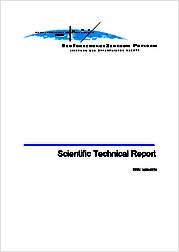| dc.contributor.author | Hemant, Kumar | |
| dc.date.accessioned | 2010-10-28T18:46:06Z | |
| dc.date.available | 2010-10-28T18:46:06Z | |
| dc.date.issued | 2003 | |
| dc.identifier.uri | http://hdl.handle.net/11858/00-1735-0000-0001-3297-6 | |
| dc.description.abstract | After a gap of nearly two decades since the Magsat mission in 1980, the dedicated low-orbit potential field mission CHAMP is now in the third of its seven year mission. Already, the new magnetic total intensity and vector data have yielded maps of the global crustal field of unprecedented accuracy and resolution. Here, we assess the value of these maps to infer deep crustal structure of regions overlain by younger cover. A GIS based modelling technique has been developed to model the various geological units of the continents starting from the geological map of the world. Depending upon the known rock types of the region, they are assigned a standard susceptibility value and using the global seismic crustal structure, a vertically integrated susceptibility (VIS) model is computed at each point of the region. Starting with this initial VIS model, the vertical field anomaly is computed at a satellite altitude of 400 km and compared with the corresponding CHAMP vertical field anomaly map. The first comparison is carried out against a model using the lateral extent of a cratonic region as given by published tectonic maps. In the subsequent modelling step, depending upon the extent of the observed anomaly pattern of that region, the surface geology is extended beneath the sediments until the recomputed map fits the observed magnetic anomaly map. Here, we focus on modelling results for the selected few provinces of the world where the initial model does not agree with the observed anomaly map. Similar modelling of CHAMP satellite magnetic anomalies can constrain the subsurface structure hidden by Phanerozoic cover in many parts of the world. | |
| dc.format.extent | 137 S. | |
| dc.format.mimetype | application/pdf | |
| dc.language.iso | deu | |
| dc.publisher | GFZ, Helmholtz-Zentrum | |
| dc.rights.uri | http://creativecommons.org/licenses/by-nc-sa/2.0/de/deed.de | |
| dc.subject.ddc | 551 | |
| dc.subject.gok | TOD 200 | |
| dc.subject.gok | TOT 330 | |
| dc.subject.gok | TOT 100 | |
| dc.subject.gok | TQI 000 | |
| dc.subject.gok | TQB 000 | |
| dc.title | Modelling and interpretation of global lithospheric magnetic anomalies | |
| dc.type | monograph | |
| dc.subject.gokverbal | Erdkruste {Geophysik} | |
| dc.subject.gokverbal | Anomalien {Geophysik: Erdmagnetismus} | |
| dc.subject.gokverbal | Methodik {Geophysik: Erdmagnetismus} | |
| dc.subject.gokverbal | Geophysikalische Satellitenfernerkundung | |
| dc.subject.gokverbal | Erdmagnetische Verfahren {Geophysik} | |
| dc.identifier.doi | 10.23689/fidgeo-519 | |
| dc.identifier.ppn | 581793919 | |
| dc.identifier.urn | urn:nbn:de:kobv:b103-03109 | |
| dc.type.version | publishedVersion | |
| dc.relation.volume | Scientific Technical Report / Geoforschungszentrum Potsdam; 2003, 10 | |
| dc.bibliographicCitation.journal | Scientific Technical Report / Geoforschungszentrum Potsdam | |
| dc.relation.collection | Geophysik | |
| dc.description.type | thesis | |



